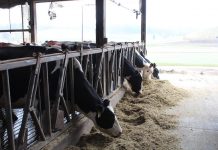COLUMBUS – Last July, U.S. milk producers became painfully aware that federal order reform initiated in January 2000 didn’t end the irritating negative producer price differential (PPD).
Producers may be surprised to get a significant negative PPD for milk shipped this April. And this could continue to occur unless changes are made to the Mideast Federal Order 33 language.
Paid first for components. In a multiple-component federal order market, such as Mideast Federal Order 33, producers are first paid for their milk components at the announced Class III butterfat, protein and other-solids prices.
In aggregate, this total dollar value, after being adjusted for total somatic cells, is what I call the “Total Producer Component Value.”
In any given month, for the entire federal order market, this “Total Producer Component Value” is subtracted from the “Total Producer Milk Value.”
As a general rule, when this subtraction is carried out, there is a surplus of dollars not accounted for by the “Total Producer Component Value.”
August example. For August 2003, this residual or excess producer milk value amounted to a negative $12,878,784.74.
Producers were paid, on a component basis, $12.8 million more than the milk was valued at in each of the class uses.
These dollars, whether positive or negative, after an adjustment for producer location and a charge for producer reserve, are divided by the total amount of milk participating or pooled in the federal order for that month and paid back to producers on a hundredweight basis.
For August 2003, each participating producer (but not all producers) had to “give-back” $1.20 per hundredweight.
This is the Producer Price Differential and for August 2003, it was negative.
Negative PPDs. The root cause of the negative PPD is reflected in the Total Producer Component Value (total value of pooled milk used within an order) exceeding the Total Producer Value of Milk (Class III value of milk components) in a given month.
Class III value is computed in an identical manner across federal milk orders. However, Class I value or price is not computed identically across orders.
Each order has an associated Class I differential that is added to the Advanced Class I price computation to arrive at the announced advanced Class I price.
The larger the Class I differential, the more protection against negative PPDs.
The $3.25 base-zone Class I differential in the Northeast Federal Order 1 provides more protection than the $2 base-zone Class I differential in the Mideast Federal Order 33, and more than the $1.80 in the Upper Midwest Federal Order 30.
A result of this “differential protection” is that, given the same market price conditions, the negative value of the PPD will not be equal across the respective multiple-component federal orders.
For example, comparing Federal Orders 1 (Northeast), 30 (Upper Midwest) and 33 (Mideast), during August 2003, the negative PPD was greatest for the Upper Midwest at $-1.58, second largest for the Mideast at a negative $1.20 and least for the Northeast at -8 cents per hundredweight.
* * *
Negative PPDs and processor equity: All are not equal
By Cameron Thraen
COLUMBUS – Buyers of milk compete for an adequate supply of milk to meet their plant and customer needs.
To attract that supply, these buyers must pay producers the federally mandated blend price and generally a premium over and above the blend price.
‘Normal’ conditions. Class I handlers are not afforded the option under Federal Milk Order rules of depooling when market price conditions might signal such an action.
So under normal conditions, Class I price exceeding Class III price, they must pay producers the blend price and any excess value must be paid into the Producer Settlement Fund.
Any over-order premiums that must be paid to attract a milk supply must come from their own operating margin.
Class III milk buyers, such as cheese plants, under these same conditions must also pay producers the blend price.
As the value of their milk is less than the blend price, these milk handlers withdraw the difference between the Uniform Price and the Class III price from the Producer Settlement Fund. Any competitive premium must also come from their operating margins.
Negative PPDs. What happens when market price circumstances create conditions for negative PPDs?
The equity situation changes significantly.
Class I handlers face a Class I and Class II price is less than the Class III price. Now it is their turn to withdraw funds from the Producer Settlement Fund because the use-value of their milk is less than the blend value paid to producers.
They pay competitive premiums from their operating margins. This is a similar scenario to the Class III milk buyer in the example above.
Depooling milk. However, Class III milk users can depool, and in this circumstance it is economically rational to do so.
With Class III price exceeding the blend price, the Class III plant, if it stayed in the market pool, would be required to pay into the Producer Settlement Fund.
By depooling their milk, they receive the use-value at the higher Class III price from which they can pay their producers both the competitive blend price and any over-order premiums required.
In essence, the Class III user, by depooling, saves the payment into the Producer Settlement Fund and uses this to pay a competitive premium to producers.
This premium does not come from their operating margin but from the dollars saved by not contributing to the Producer Settlement Fund.
The ability to voluntarily depool tilts the playing field in favor of the Class III milk plants.
STAY INFORMED. SIGN UP!
Up-to-date agriculture news in your inbox!












